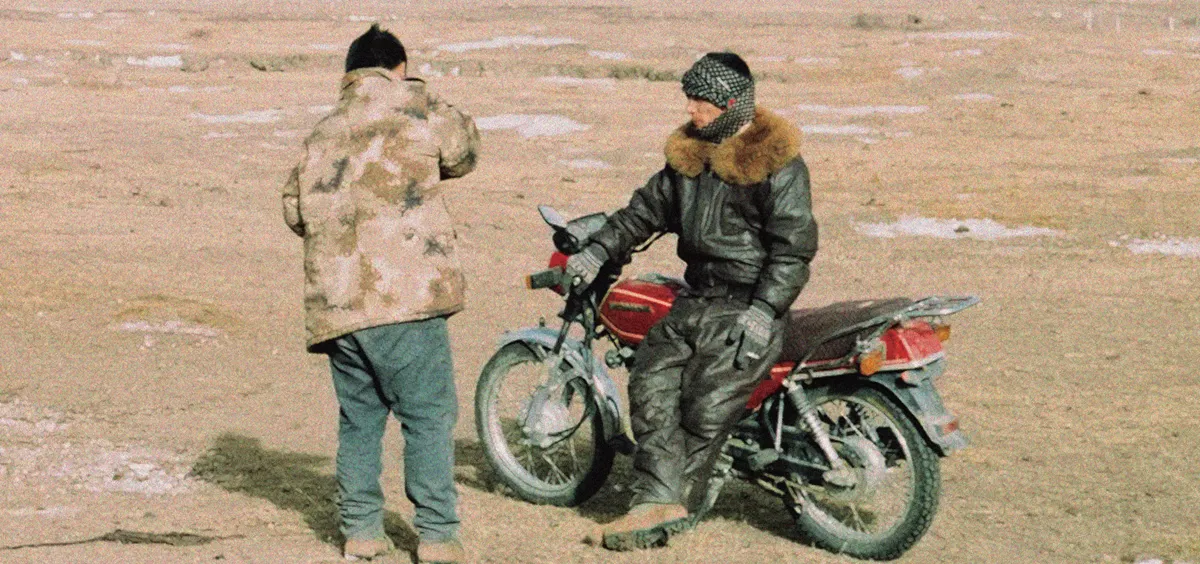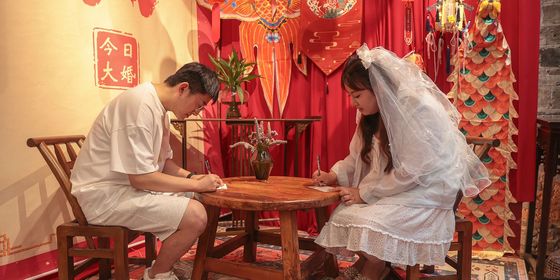Freewheeling motorbike cultures in the Middle Kingdom
I can hear the beastly engines revving from hundreds of meters away. Up close, the machines gleam in the autumn sun. Benellis, chrome Harley Davidsons, dark-tinted BMWs, and Shinerays are all lined up for display on the deck of an abandoned freight train platform in Beijing’s 798 Art District.
“I come here every weekend to meet the others—this is a lifestyle,” a motorbiker surnamed Wang says through the gasoline fumes that hover between men and machines in the square. He is sitting on a concrete boulder, facing a dozen or so motorbikes that are parked in front of the Ace Cafe, a world-renowned British franchise (at least for motorbike enthusiasts) that is the go-to hangout spot for Beijing’s bikers. This is both because of its decor and because “dog riders,” as seasoned riders are called in biker lingo, get 10 percent off on any order when they arrive on a motorbike.
I have seen many “dog riders” out on the roads over the past eight years on my own motorbike adventures around China. They wear full-body black leather suits and colorful helmets, giving thumbs ups as they drive by and causing heads to turn. I have also seen many other uses of the motorbike in China—as a tool, a source of pride, and even as a companion.
Through 30,000 kilometers of motorbike journeys, and interactions with riders of all ages and classes, three motorbike cultures have stood out to me for their embrace of the bike as more than just a mode of transportation: among the Tibetan herders of Sichuan, in the coal country of Guizhou, and in the gleaming capital of Beijing.
Although the first motorbikes arrived in China in the early 1900s, homegrown production didn’t commence until 1951 when the People’s Liberation Army started making military motorbikes based on the design of the German K500 for the Korean War. Mass production only began in Chongqing, Guangdong province, and Zhejiang province after market reforms kicked in during the late 1980s and early 90s. These three manufacturing hubs churned out millions of cheap two-wheeled, gasoline-engine vehicles that quickly became a household item all over China.
Tibetan riders adorn their motorbikes with protective symbols and talismans
One of the most iconic vehicles of this era is the Honda Dayang, which started production in 1992 through a joint-venture between Japan’s Honda Motors and the Guangzhou Motors Group. This was one of the most popular motorbikes in history: It has been produced in the tens of millions. It owes its popularity mainly to two qualities—it is cheap and reliable.
From 1992 onward, the Chinese domestic market grew to 4 million motorbikes, and reached nearly 20 million in the 2000s. As the Chinese government enacted restrictions to address air pollution and safety issues caused by the large number of motorbikes in urban areas, commuters switched to electric scooters, which have much more relaxed licensing requirements and looser regulations, causing the motorbike market to cool. Today there is one motorbike for every five households in China.
Cheap motorbikes have turned into a symbol of backwardness. In cities such as Beijing and Shanghai, they have almost entirely disappeared under the joint forces of regulation and economic development. Only the extremes remain: The secondhand tiddlers which rural riders commandeer on remote or difficult landscapes, or the vastly more expensive imports that are parked outside the Ace Cafe. For work or necessity, leisure or identity, the wheels are continuing to turn in China’s unique motorbike cultures.
Herding on two wheels
Far from the expensive motorbikes of the capital, at altitudes ranging from 3,000 to 3,500 meters, Tibetan herders dart out over the highland steppes on red Lisans, Hondas, and Suzukis. It is time for the yearly administering of worm cures for the oxen, and I have arrived just in time to participate. We assemble by the side of a dirt road next to three motorbikes.
“I prefer this one,” a young herder named Gdong Dkar says, pointing at a bright red Honda model called Dayang, or Great Sun, “but I also drive cars and tractors.” Not bad for a 14-year-old.
Here in Hongyuan county, in the Aba region of northern Sichuan province, herders put their driving skills to good use out on the highland terrain. The motorbike has virtually replaced the horse as the favored mode of transportation, because it works well in off-road conditions and requires less maintenance than a live animal. Some herders have even fitted their bikes with the Kalachakra symbol, prayer flags, swastikas, and even golden plastic prayer mills, making small mobile shrines that protect them on their way.
Rural students often move to town for education, leaving small schools in more remote villages
In the distance, I can see the yaks, looking no bigger than black dots on the horizon. “You drive to the right, I will take the left,” Kelsang, the lead herder, orders like a field commander directing divisions to partake in a grand pincer maneuver. He turns to me and a female herder and instructs, “When [the yaks] come this way, you need to wave your arms, yell, and make yourselves as big as you can—do not let them get past you.”
To our left is a scantily built pen made from bricks, stones, and green tarp. The idea is to lure the reluctant yak herd into the pen, where they can be given the worm cure. The young Tibetan herders mount the motorbikes and race out over the steppes. From my position I see them getting in formation, speeding toward the herd before splitting up—two going around each side of the herd, and the last motorbiker ready to pick up any strays.
“Uuuuuoooo!” I can hear the loud cries of the herders, before the ground starts shaking under my feet as about 50 yaks come thundering straight toward us. The female herder throws her arms in the air and starts walking steadily toward the incoming oxen, each of them weighing 250 to 500 kilograms. I am terrified, but I follow her example, and we both yell and wave our arms frantically toward the pen.
Just when the herd is about to reach us, the yak in the front veers into the pen and the rest follow. After the bulk of the yaks have entered the enclosure, I run over to seal the opening with a tarp. Together with the female herder, I tie the ends of the tarp to a metal rod and reinforce it at the bottom with bricks and boulders. The work is backbreaking, but the herders are used to it; I am not. The first part of the job is done, except for two yaks that have sensed the trap and strayed off course. One of the bikers immediately sets off to chase them back.
Afterward, we assemble by the pen. “This is my good friend,” Kelsang says, patting his motorbike on the gasoline tank. These motorbikes cost around 3,000 RMB, and the registration for the plates is another few hundred yuan. On the steppe, there is a vibrant secondhand bike-trade economy, though many of the dilapidated vehicles are not registered, and will be kept out on the grasslands away from the eyes of local authorities.
Blood flows, and a butcher’s motorbike is a beast of burden in Guizhou province
For protection—from crashes or confiscation—Gdong Dkar shows me where to put the Kalachakra. It is a lamaist symbol meant to protect anything it is fitted on. I have put one on the gas tank of my motorbike. “This is not a good place to put it,” he tells me. “It should be facing the direction where dangers usually come from. The front.”
“You gotta be careful when you drive,” says Kelsang. He is wearing a big dark brown fur jacket with a purple belt and a scarf around his head—but no helmet. “There are many ways to crash on the grasslands. The ground is uneven and in the summer it will get muddy.” Even though many of these men grew up with motorbikes, learning the basics of driving around the same time they learned how to read, most have stories or scars from accidents.
Less obvious, but equally dreaded among the herders, are the cold temperatures that will slowly eat at the joints and cause chronic pain to the knees. “You need to be safe and make sure your joints are kept warm. Many herders get bad knees at age 30-35 because of the chills,” Kelsang says. There is no technical term for this, but in some biking communities it is known as “burning knees.” “You won’t feel it in your knees now, but slowly it will freeze through your sinews.”
James Dean of the mountains
In the karst hills of Guizhou province, I meet motorbikers who are young men working in the local coal plants. “Don’t touch their motorcycles; they might take it the wrong way,” a local friend named Cai Hen tells me. Cai grew up here in Liupanshui, a largely rural area of 2.8 million residents in western Guizhou, and counts many bikers among his friends and family.
Cai’s friends, cousins, and uncles can swing the handle of a motorbike like few others. They have also never left the countryside to work in the city, unlike Cai himself. This is coal country, a rust belt of old coal processing facilities in the Guizhou mountains, where state-owned plants are mixed with local operations that together hold a monopoly on trade and extraction. “The people who stay mostly join local companies, and on the weekends, they drive to the market or the abandoned factories to party,” Cai says.
We enter the grounds of a former coal factory where Cai’s cousin, Cai Liu, is waiting for us. He is wearing a leather jacket and biting on the end of his cigarette. “Do you know how to drive one of these?” he asks me, nodding at the red motorbike in front of him. Dried mud covers the track guards, and it is rusted at the rear suspension.
A rider of a Fekon motorbike chats up women at a village market in Guizhou
“I do,” I say, but I am slightly intimidated. I know I will not be able to drive with the same skill, gusto, and flamboyance as this 20-year-old youngster.
In the mountains, suave Chinese James Deans like Cai Liu, in leather jackets and slicked-back 30 yuan hairdos, drive their motorbikes around the treacherous roads to impress their sweethearts.
“The girls like to drive with us,” he says, “but their parents don’t like it when they do.”
Here, several generations of Chinese youngsters have grown up with the motorbike as the vehicle of their dreams and affection, much like the Cadillacs and Thunderbirds of 1950s and 60s American suburbia. Driving from early age gives them incredible command of their two-wheeled vehicle. The legal driving age for motorbikes in China is 18, but due to the great number of motorbikes that are on the roads in this part of the country, it is not uncommon to see kids as young as 12 racing by on two wheels.
Being around motorbikes their entire lives, they learn the tricks by observing and learning from their elder siblings, parents, or relatives. Near collisions seem to happen constantly, and movements are done on the whim of instinct rather than thinking your way through traffic. “[My family] used to share one motorbike, but when I got a job, I bought my own,” Cai Liu says.
Up until the mid-2010s, the majority of motorbikes on the roads in China were not properly registered. The bikes occupied their own gray area, tolerated by the police because it plays an integral part of the local economy and transportation system. Illegal vehicles were easily obtained secondhand through local black markets. This has intensified over the past decade, as the motorbikes were first pushed out of the city, then put under increasing restrictions in the countryside.
Bikers gather every weekend in a converted railways storage facility in Beijing’s 798 Art District
Having been the vehicle of choice in urban and rural areas—capable of transporting anything including crops, chickens, geese, or several family members at a time—the motorbike was made the target of a series of government policies. Millions of bikes were taken off the streets by the police during criminal cleanup campaigns from 2015 onward. Routine checks and raids are now carried out. All motorbikes have to be registered at the local motor vehicles department, and the drivers have to carry a motorbike license, or the police may confiscate the motorbike and slap the driver with criminal charges.
In the mountains of Guizhou, though, the motorbike is still thriving. There are plenty of un-registered motorbikes on the roads, many without license plates entirely. Police occasionally grab motorbikes off the street just to be seen as making an effort and meet local government targets.
This is a prospect dreaded by the local bikers. Many of the youngsters feel trapped here in the countryside, away from better job prospects and the lives reflected in the soap operas they watch on their smart phones. If they lose their motorbike, they will lose a part of their identity.
They seem disgruntled, stuck in the mountains, and the frustration comes out on the weekends. “There are often fights at the factory parties. Once a guy got stabbed and everyone fled as fast as they could before the police arrived,” Cai Liu reminisces. They know that the area is underdeveloped, but on the motorbike, it seems like they can outrun that for a moment.
Motor Aces
Back in Beijing, Wang the biker and I are walking among the motorbikes in 798. “This one costs about 400,000 RMB.” He points to a newly polished Harley Davidson, which is attracting a lot of attention from other “dog riders” and passersby.
“Many of the guys only like their bikes for a couple of months, just like their girlfriends.” He laughs before he goes on. “Then they go on [e-commerce app] Xianyu and exchange their bike for something different.”
But the secondhand game in 798 and the motorbikers in Sichuan and Guizhou are worlds apart. You can still find relatively cheap bikes on Xianyu in Beijing, with or without license plates. The Suzuki 125 GN that I own was bought with a “Jing B” plate for 5,000 RMB, the same design as those that can be acquired secondhand for a couple of hundred yuan in other provinces. The license plate itself costs between 1,000 to 1,500 RMB, but it is only valid to drive outside Beijing’s Fourth Ring Road, so seasoned riders are less than impressed.
Every motorbike is an expression of identity in 798
The leisure motorbikers resell their bikes because they want to try out other models. The Harley Davidson that is the awe of the day in 798 has been imported from the US and carries the coveted “Jing A” license plate, which allows the driver access to all districts of Beijing. Because no new Jing A plates are issued anymore, its price has skyrocketed—as of 2020, a Jing A license plate cost between 80,000 and 100,000 RMB, in addition to the cost of the bike.
Anyone who owns these plates is running an expensive hobby, and most of the motorbikes in 798 carry Jing A plates. It is a part of this motorbike culture to revel in the beauty of the machine and gain the respect of other dog riders.
Wang is wearing a six-pence cap. A 52-year-old robotics engineer with two motorbikes and a couple of cars in his garage in southern Beijing, he is the leader of a group of motorbike fans known as the Lucky Number 16. The 149 members of their WeChat group routinely share pictures of motorbikes and the landscapes they travel through on their two-wheelers, and many of them meet at the Ace Cafe with their motorbikes every weekend.
“We are all very peaceful. We like to drink beer, talk about motorbikes and crack jokes,” says Wang. They are inspired by American television series like Sons of Anarchy, but fix a Peppa Pig sticker on their bikes, rather than skulls. “On the motorbike you can get close to nature and you can feel the wind in your face and see the landscape roll by.”
After hanging out for a couple of hours in front of the Ace Cafe, inspecting each other’s rides, and exchanging tips on anything from gear to motorbike regulations, the gangs drive to the outskirts of Beijing to Huairou and Yanqing district or to the Western Hills to enjoy the countryside—and to show off together. “There are many beautiful roads out there; especially in the Western Hills, but they are also the most dangerous ones,” Wang says.
I know what he is talking about. People get carried away and drive recklessly on the mountain roads. I have seen the videos of horrific accidents: a person being hurled through the air after a failed attempt to overtake through a left turn in the mountains, and colliding head-on with a car coming from the opposite direction around the bend; a man covered in blood under his unzipped leather suit, with a crushed motorbike beside him.
The dangers of the motorbike exist in all parts of China, from Sichuan and Guizhou to Beijing. The difference is whether the bikers choose this lifestyle and all its risks, or grow up with it because there was not much else to choose from.
“Sometimes people forget the immense raw power of their bikes,” says Wang. “When you drive, you need to be careful at every moment. It only takes one second of unawareness for you to crash—and you’re toast!”
Photos by Mads Vesterager Nielsen
Ride or Die is a story from our issue, “You and AI.” To read the entire issue, become a subscriber and receive the full magazine.












